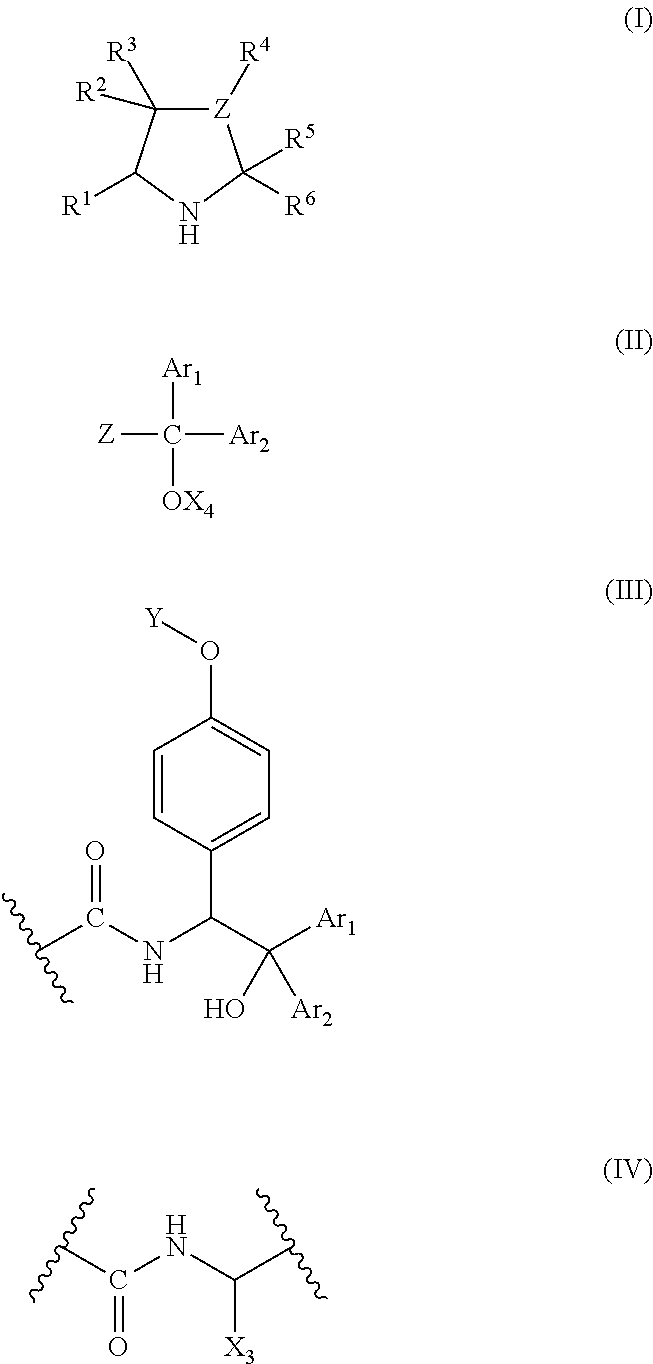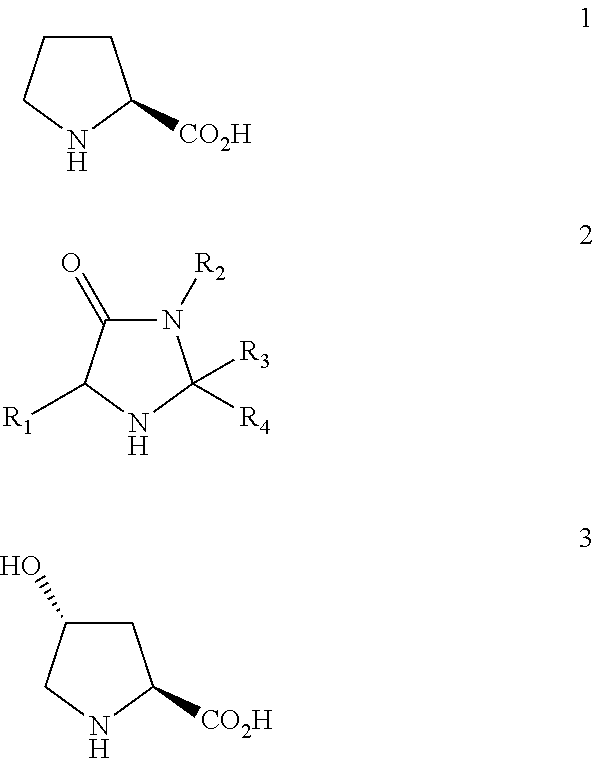Polymer organocatalyst and preparation process
a polymer organocatalyst and polymer technology, applied in the field of chiral polymer organocatalysts, can solve the problems of difficult separation of desired products from the catalyst used in these reactions, inability to adapt to the reaction conditions of immobilized catalysts, and inability to adapt to the reaction conditions. , to achieve the effect of enhancing stereoselectivity, enhancing the flexibility of the catalyst, and reducing the number of reaction conditions
- Summary
- Abstract
- Description
- Claims
- Application Information
AI Technical Summary
Benefits of technology
Problems solved by technology
Method used
Image
Examples
example 1
O-Acryloyl-trans-4-hydroxy-L-proline hydrochloride
[0065]
[0066]Dried and powdered trans-4-hydroxy-L-proline (12.81 g, 97.7 mmol, dried at 65° C. for 17 h) was charged into a 250 ml round-bottom glass flask and cooled in an ice / water-bath. Trifluoroacetic acid (30 ml) was added and the mixture stirred vigorously for 10 min, dissolving most of the hydroxyproline to give a viscous solution, but leaving pieces of undissolved material. Trifluoromethanesulfonic acid (1.0 ml, 11.5 mmol) was added under stirring and the reaction flask was then removed from the ice / water bath and stirred at room temperature for 10 min. Acryloyl chloride (15.8 ml, 195 mmol) was added, the reaction flask was fitted with a loose glass stopper and the reaction mixture was stirred at room temperature without any external temperature adjustment for 2 h (a clear and colourless solution with no undissolved material was obtained after ˜40 min). The reaction flask was then cooled in an ice / water-bath and diethyl ether ...
example 2
Poly(O-acryloyl-trans-4-hydroxy-L-proline hydrochloride)
[0067]
[0068]O-Acryloyl-trans-4-hydroxy-L-proline hydrochloride (1.77 g, 7.99 mmol), prepared as described in example 1, was dissolved in water (10 ml) that had been heated close to the boiling point under vigorous stirring overnight to remove oxygen. The solution was stirred at 65° C. for 15 min and flushed with nitrogen. 2,2′-Azobis(isobutyramidine hydrochloride) (AAPH, 35 mg) was added and the solution was stirred at 65-70° C. for 4 h under nitrogen and cooled to room temperature. The solution was poured into isopropanol (100 ml) and the precipitated polymer was isolated by filtration, washed with ethanol (96 vol %) and dried under vacuum over anhydrous calcium chloride for 21 h at room temperature to give poly(O-acryloyl-trans-4-hydroxy-L-proline hydrochloride) (1.48 g, 84%) as a nearly colourless solid.
example 3
Poly(O-acryloyl-trans-4-hydroxy-L-proline hydrochloride)
[0069]
[0070]Ethanol (96 vol %) was heated to 70° C. and stirred at this temperature for 1 h to remove oxygen. O-Acryloyl-trans-4-hydroxy-L-proline hydrochloride (1.29 g, 5.82 mmol), prepared as described in example 1, was dissolved in this ethanol (10 ml) at 60-65° C. under gentle swirling (no stirring bar was added). The reaction flask was flushed with nitrogen and 2,2′-azobis(isobutyronitrile) (AIBN, 21 mg) was added. The reaction flask (without stirring) was kept at 60° C. in a bath of glycerol for 22 h under nitrogen. After cooling to room temperature, the precipitated polymer was filtered by vacuum, washed with isopropanol and dried at room temperature for 4 h and then for 19 h under vacuum over anhydrous calcium chloride at room temperature to give poly(O-acryloyl-trans-4-hydroxy-L-proline hydrochloride) (0.85 g, 66%) as a colourless solid. By using an analogous procedure with magnetic stirring and addition of a small amo...
PUM
| Property | Measurement | Unit |
|---|---|---|
| Structure | aaaaa | aaaaa |
| Polymer chain length | aaaaa | aaaaa |
Abstract
Description
Claims
Application Information
 Login to View More
Login to View More - R&D
- Intellectual Property
- Life Sciences
- Materials
- Tech Scout
- Unparalleled Data Quality
- Higher Quality Content
- 60% Fewer Hallucinations
Browse by: Latest US Patents, China's latest patents, Technical Efficacy Thesaurus, Application Domain, Technology Topic, Popular Technical Reports.
© 2025 PatSnap. All rights reserved.Legal|Privacy policy|Modern Slavery Act Transparency Statement|Sitemap|About US| Contact US: help@patsnap.com



